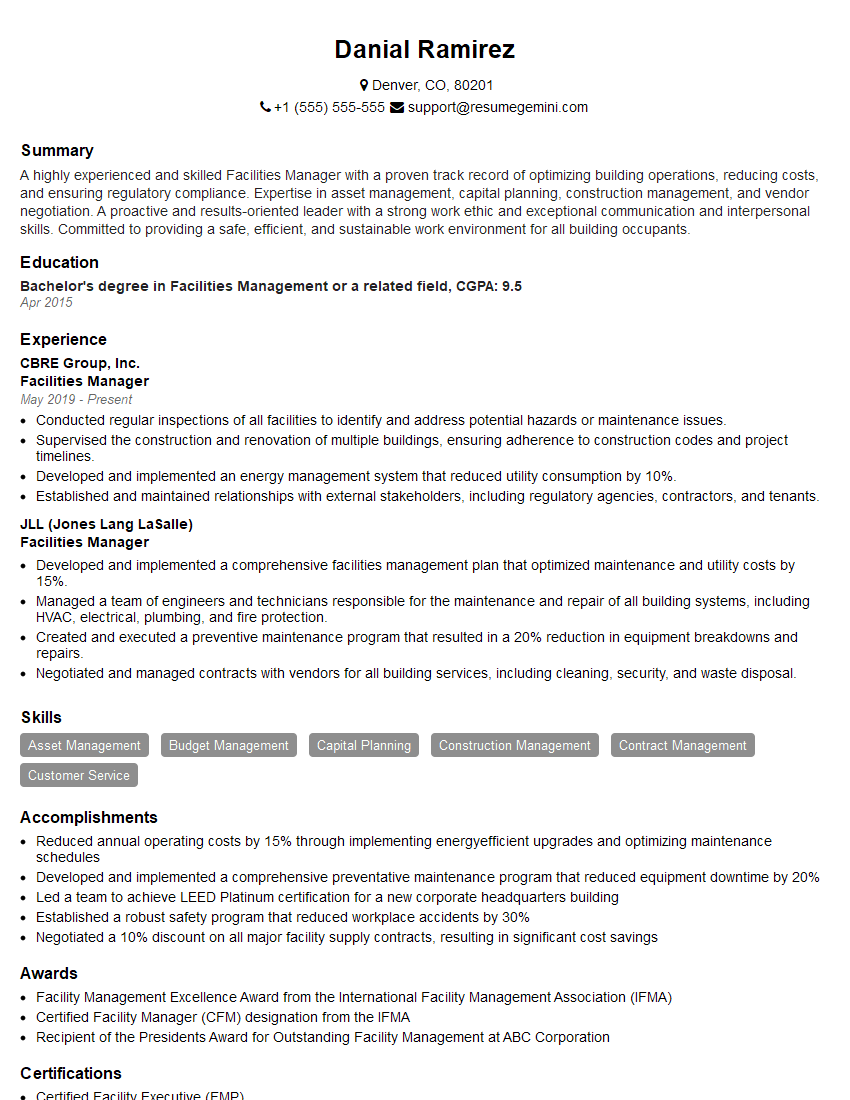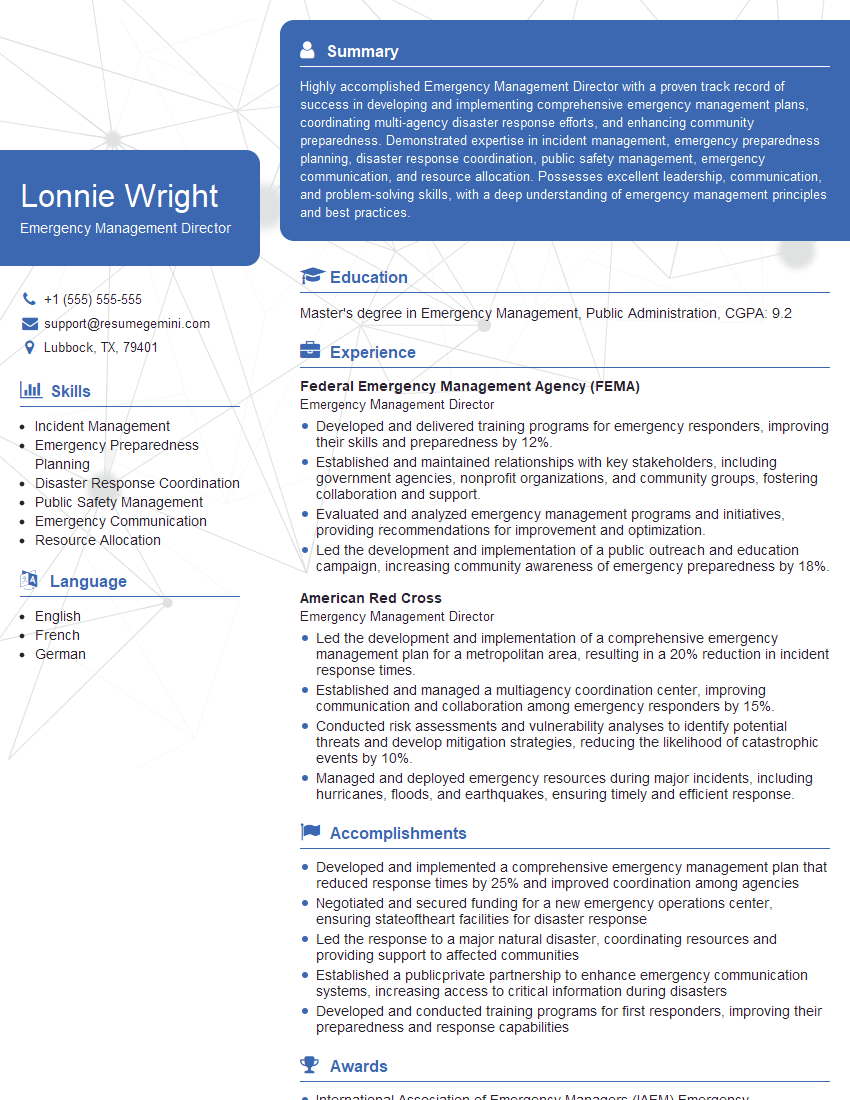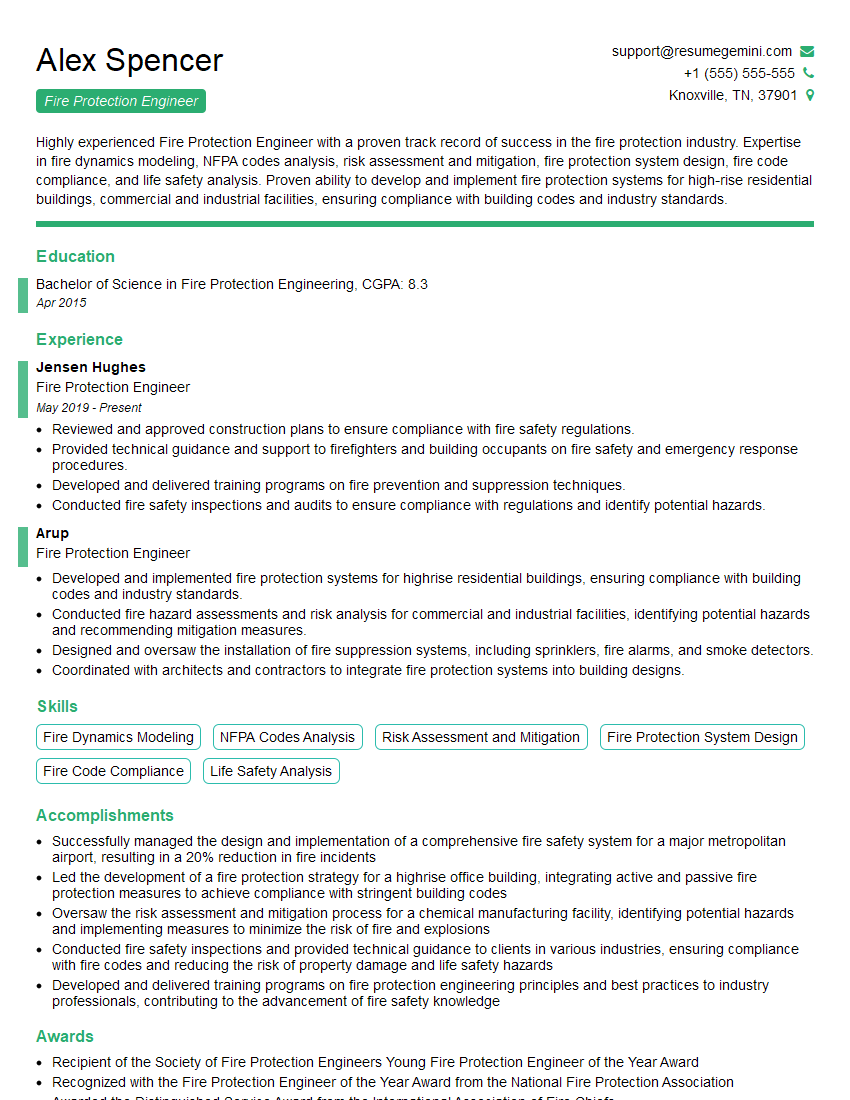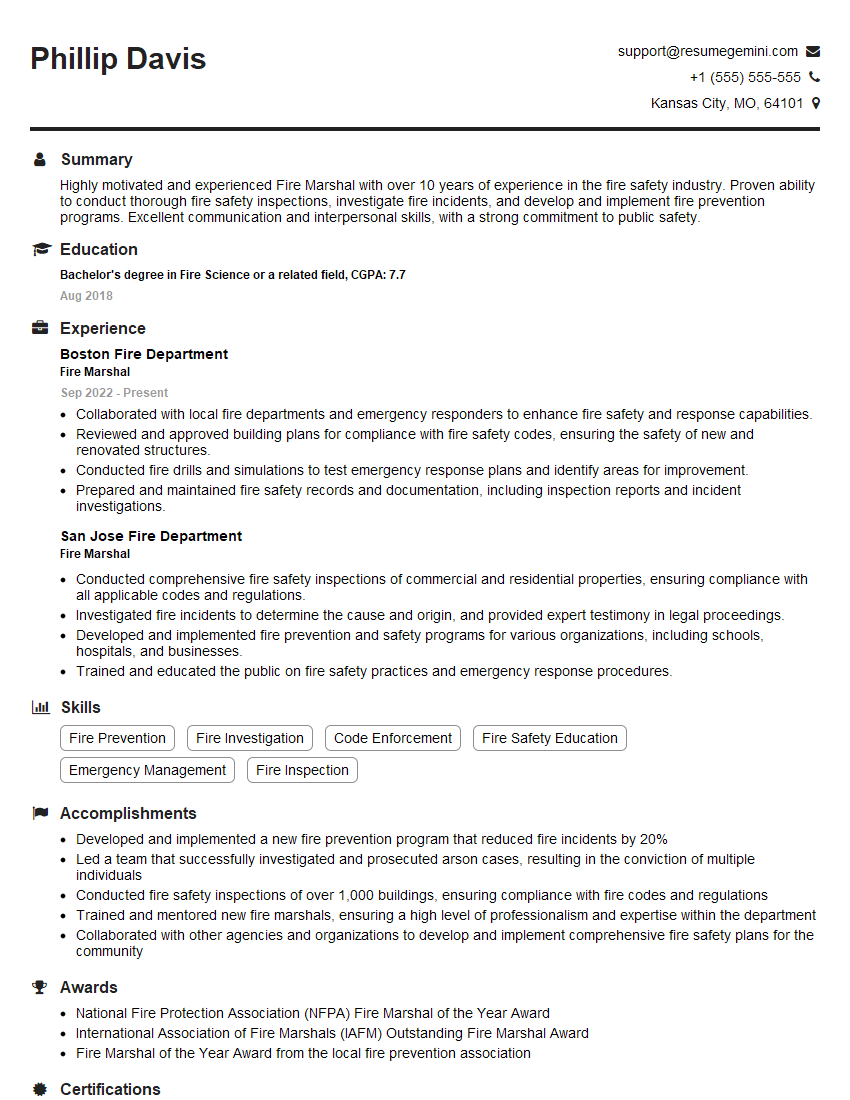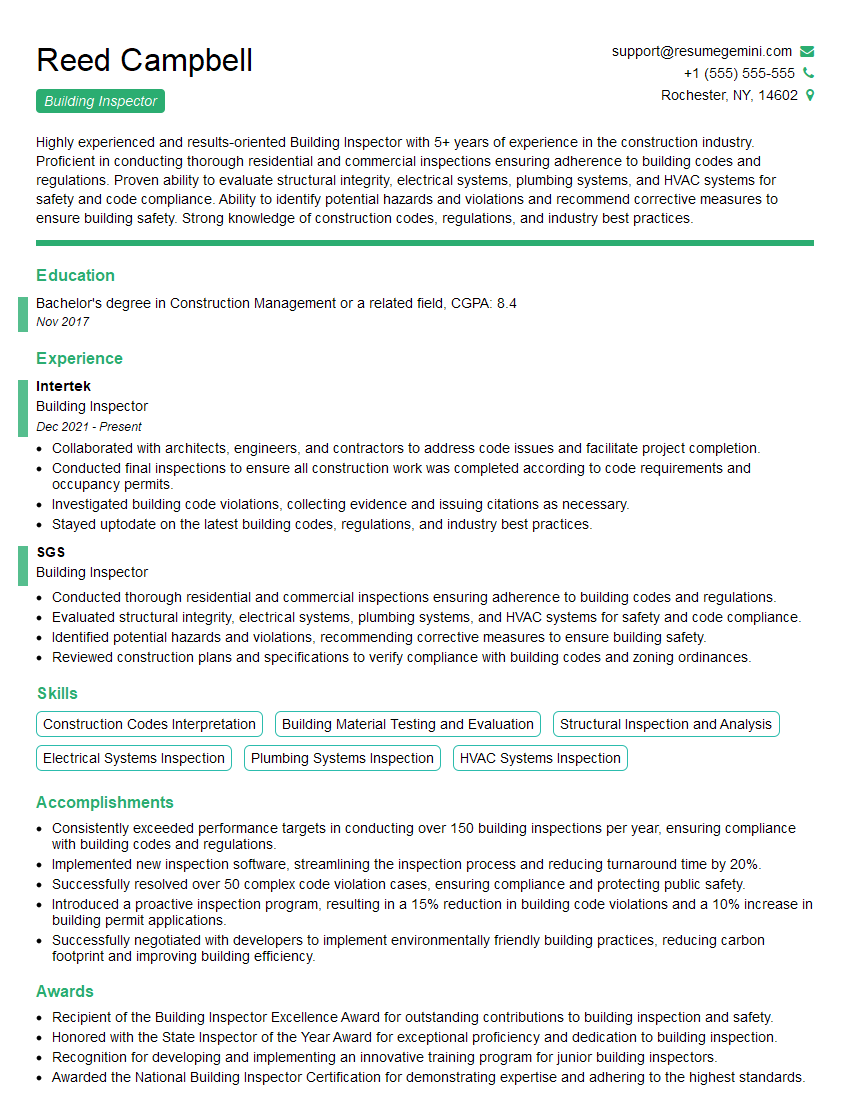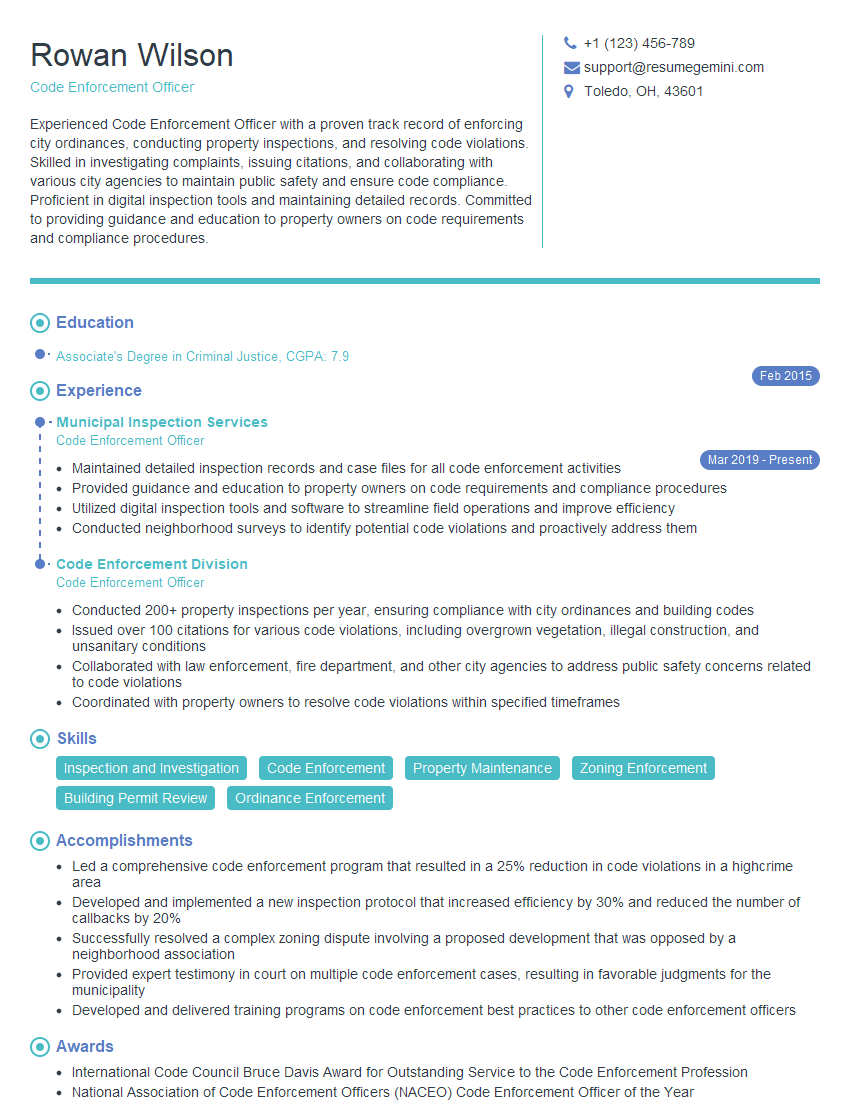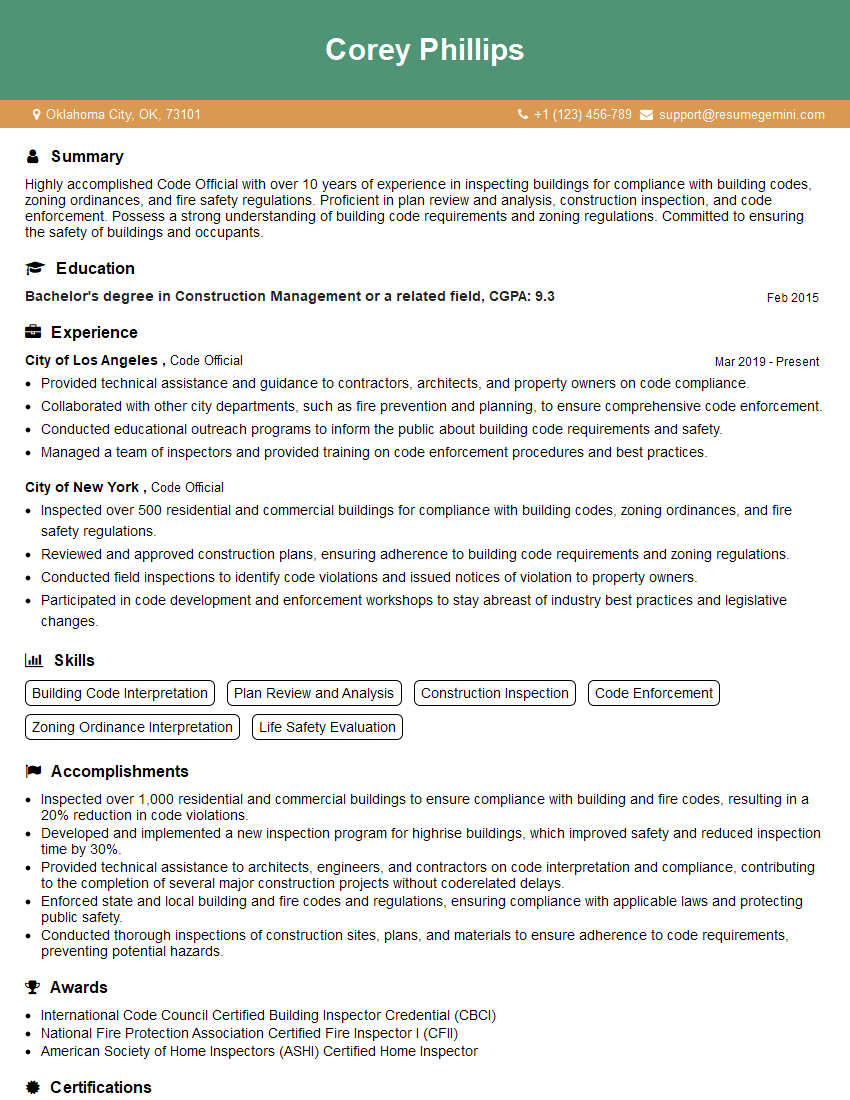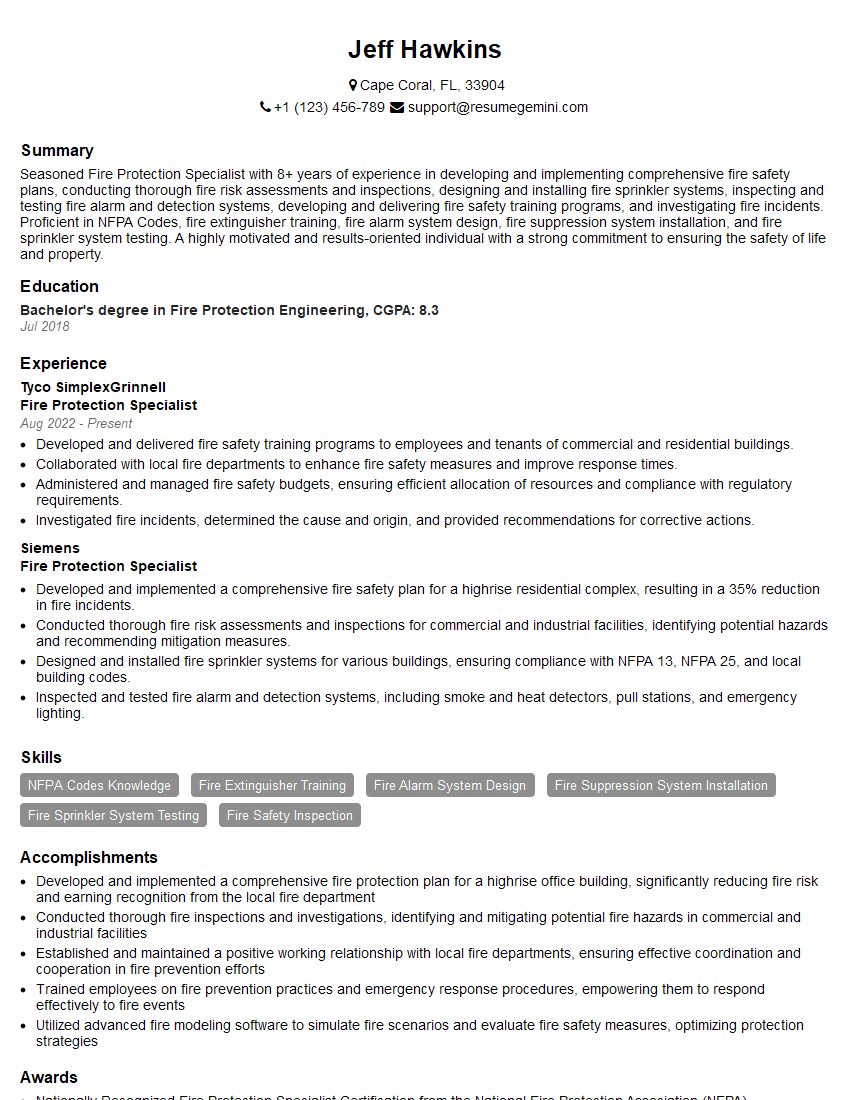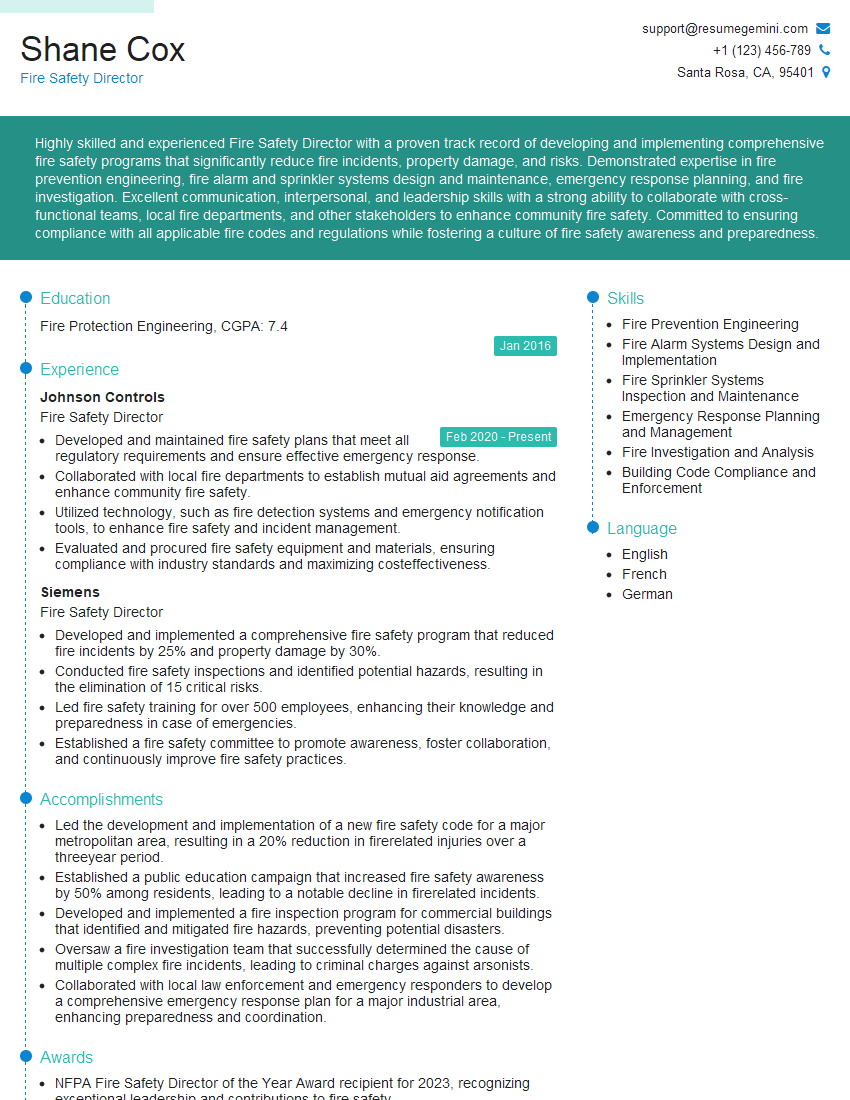Preparation is the key to success in any interview. In this post, we’ll explore crucial NFPA 101 (Life Safety Code) interview questions and equip you with strategies to craft impactful answers. Whether you’re a beginner or a pro, these tips will elevate your preparation.
Questions Asked in NFPA 101 (Life Safety Code) Interview
Q 1. Explain the difference between NFPA 101 and NFPA 72.
NFPA 101, the Life Safety Code, and NFPA 72, the National Fire Alarm and Signaling Code, are both crucial for fire safety, but they address different aspects. Think of it like this: NFPA 101 is the overall blueprint for building safety, encompassing everything from exits to fire suppression, while NFPA 72 focuses specifically on the design, installation, and maintenance of fire alarm systems.
NFPA 101 sets the requirements for building construction, design, and operational features to ensure life safety during a fire. This includes means of egress, fire protection systems (sprinklers, standpipes), emergency lighting, and more. NFPA 72, on the other hand, details the technical specifications for fire alarm systems, including notification appliances, control panels, and system testing procedures. A building might comply with NFPA 101’s requirements for a fire alarm system, but the specific implementation must then meet the detailed standards outlined in NFPA 72.
In essence, NFPA 101 establishes the *what* and *why* of life safety, while NFPA 72 dictates the *how* for a crucial component: the fire alarm system.
Q 2. Describe the process of conducting a Life Safety Code audit.
Conducting a Life Safety Code audit is a systematic process of evaluating a building’s compliance with NFPA 101. It involves a thorough inspection and review of the building’s design, construction, and operational features. Imagine it like a thorough medical checkup for a building.
- Pre-audit planning: This includes reviewing building plans, identifying areas of potential concern, and scheduling the inspection.
- On-site inspection: A qualified professional conducts a detailed walk-through, checking for compliance with specific NFPA 101 requirements. This involves examining means of egress, fire protection systems, emergency lighting, signage, and more.
- Documentation review: Reviewing building permits, inspection reports, and maintenance records to verify that systems are up-to-date and functioning correctly.
- Report preparation: A comprehensive report detailing findings, areas of compliance and non-compliance, and recommendations for corrective actions is generated.
- Follow-up: After the corrective actions are implemented, another inspection might be needed to verify compliance.
For example, a Life Safety Code audit might reveal a blocked exit route, a malfunctioning sprinkler head, or inadequate emergency lighting. The audit report then provides detailed recommendations to address these deficiencies.
Q 3. What are the key requirements for means of egress in NFPA 101?
Means of egress in NFPA 101 are the paths of exit from a building in case of a fire. Imagine them as escape routes from a burning building. Key requirements include:
- Number and arrangement: Sufficient exits must be provided to allow for safe evacuation within a reasonable time, considering occupancy load.
- Separation: Exits must be separated from each other to prevent a single event from blocking all escape routes.
- Accessibility: Exits must be accessible to all occupants, including people with disabilities. This often involves ramps, elevators, and appropriate signage.
- Width and capacity: Exits must be wide enough to accommodate the expected flow of people, and the entire egress system must have adequate capacity.
- Illumination: Adequate lighting must be provided in all exit pathways.
- Signage: Clear and visible exit signage is crucial to guide occupants to safety.
- Construction: Exit routes must be constructed of fire-resistant materials to withstand fire conditions.
For example, a large office building might require multiple stairwells, strategically located exits, and wide corridors to ensure sufficient capacity for a quick and safe evacuation.
Q 4. How does NFPA 101 address fire alarm systems?
NFPA 101 mandates the installation and maintenance of fire alarm systems in most buildings. It doesn’t specify the *exact* system design, leaving that to NFPA 72, but it dictates the *necessity* and *functionality*.
NFPA 101 requires fire alarm systems to provide:
- Early warning: Prompt detection and notification of fire conditions to occupants.
- Notification: Audible and visual alarms to alert occupants of the fire.
- Activation: Automatic detection (smoke detectors, heat detectors) and manual activation (pull stations) to initiate the alarm.
- System testing: Regular testing and maintenance to ensure the system’s reliability.
The specific type of fire alarm system (e.g., addressable, conventional) is dictated by NFPA 72 and factors like building size and occupancy. However, NFPA 101 ensures that a suitable system, meeting NFPA 72 requirements, is in place to promptly alert building occupants.
Q 5. What are the requirements for smoke control systems according to NFPA 101?
NFPA 101 addresses smoke control systems as a critical component for life safety, especially in high-rise buildings and large spaces. Smoke control systems are designed to limit the spread of smoke and toxic gases during a fire, providing a safer evacuation route and protecting areas not directly impacted by the fire. Think of them as creating breathable zones within a smoke-filled building.
The specific requirements for smoke control systems vary depending on the building’s type and occupancy. Key aspects covered by NFPA 101 include:
- System design: The design must be based on a proper smoke management plan, considering factors like building layout, ventilation systems, and fire scenarios.
- Components: This could involve smoke dampers, pressurization systems, exhaust fans, and smoke detectors.
- Testing and maintenance: Regular testing and maintenance of the system are essential to ensure its effectiveness.
- Integration with other systems: Smoke control systems must be integrated with other fire safety systems, such as the fire alarm system.
For example, a high-rise building might utilize a combination of smoke dampers, stairwell pressurization, and smoke exhaust systems to maintain safe evacuation routes and prevent smoke from spreading to other floors.
Q 6. Explain the importance of fire-resistant construction materials as outlined in NFPA 101.
Fire-resistant construction materials are essential for life safety as they delay the spread of fire, providing occupants with valuable time to escape. They act as a fire barrier, slowing down the progression of fire and reducing its intensity. Imagine them as a protective shield against the rapid spread of flames.
NFPA 101 specifies fire-resistance ratings for various building components based on the building’s occupancy and construction type. These ratings indicate how long a material can withstand fire exposure before failing. The code outlines requirements for:
- Structural members: Columns, beams, and other structural elements must be able to withstand fire for a specified duration, preventing structural collapse.
- Walls and floors: Fire-rated walls and floors create fire barriers, separating different areas of the building and limiting fire spread.
- Doors and windows: Fire-rated doors and windows further impede fire spread.
The use of fire-resistant materials significantly enhances the building’s safety, allowing for a safer and more effective evacuation during a fire. For instance, a fire-rated wall in a hospital could protect patients in adjacent rooms while allowing firefighters to extinguish the fire more effectively.
Q 7. What are the key requirements for emergency lighting and exit signs under NFPA 101?
Emergency lighting and exit signs are crucial for guiding occupants to safety during a power outage or fire. Think of them as the vital signposts during an emergency. NFPA 101 mandates their installation and maintenance to ensure visibility and effective evacuation.
Key requirements include:
- Type of lighting: Emergency lighting systems must provide sufficient illumination in exit routes, ensuring occupants can safely navigate to exits.
- Duration of illumination: Emergency lighting must remain operational for a specified period, generally 90 minutes, after a power failure.
- Exit signs: Clearly visible and appropriately placed exit signs must be provided throughout the building to direct occupants to the nearest exits.
- Maintenance: Regular testing and maintenance of emergency lighting and exit signs are vital to ensure their continued functionality.
For example, a cinema would need sufficient emergency lighting in hallways and stairwells, along with clearly marked exit signs, guiding patrons to the nearest exits in case of a power failure or fire.
Q 8. How does NFPA 101 address accessibility for people with disabilities?
NFPA 101, the Life Safety Code, extensively addresses accessibility for people with disabilities, aligning with the Americans with Disabilities Act (ADA). It mandates features ensuring safe egress for individuals with mobility, visual, and hearing impairments. This includes provisions for:
- Accessible routes: Ramps, elevators, and properly designed hallways with adequate width and clear floor space for wheelchair maneuvering are crucial. Imagine a scenario where a fire breaks out – a wheelchair user needs a clear, unobstructed path to the nearest exit.
- Accessible exits: Exits must comply with dimensions specified in the code, ensuring easy passage for those using wheelchairs or other mobility devices. This includes considerations for door hardware and signage placement.
- Accessible alarm systems: Visual and audible alarms are required to ensure that individuals with hearing impairments are alerted to emergencies. Visual alarms, such as strobe lights, need to be strategically positioned and sufficiently bright.
- Accessible signage: Signage must be clear, concise, and appropriately sized, incorporating tactile and Braille characters where necessary. Think about directional signage leading to exits; they must be easily understood by everyone.
Failure to adhere to these accessibility requirements can lead to severe consequences, including lawsuits and potential loss of life in emergency situations. A building’s accessibility is not just a matter of compliance; it’s a matter of life safety and social responsibility.
Q 9. Describe the process of evaluating a building’s compliance with NFPA 101.
Evaluating a building’s compliance with NFPA 101 involves a multi-step process. It usually starts with a thorough review of the building’s plans and documentation to ensure that it was designed to meet the code. This is followed by a physical inspection of the building to verify that the actual construction matches the design and conforms to the code’s requirements.
The process typically includes:
- Document Review: Examining building plans, permits, and any existing fire safety reports to identify potential discrepancies or areas of concern.
- On-site Inspection: A physical inspection of the building, verifying compliance with the code’s provisions related to means of egress, fire protection systems, and other life safety features. This may involve using specialized equipment to assess things like sprinkler system pressure.
- Testing and Inspections of Systems: This includes testing fire alarms, sprinkler systems, and other life safety systems to ensure functionality. This is not merely a visual inspection, it involves confirming proper operation under various scenarios.
- Reporting and Recommendations: The inspector will compile their findings in a formal report detailing any deficiencies discovered and recommending corrective actions to address the identified non-compliance issues.
The process often involves qualified professionals, like fire protection engineers or certified fire inspectors, who are knowledgeable in interpreting and applying NFPA 101. The goal is not merely to find violations, but to identify vulnerabilities that could threaten life safety and to implement solutions to mitigate these risks.
Q 10. What are the different types of occupancy classifications in NFPA 101 and their implications?
NFPA 101 uses a system of occupancy classifications to categorize buildings based on their primary use. This is crucial because the fire safety requirements vary significantly depending on the type of occupancy. For example, a hospital will have different requirements than a high-rise apartment building. Here are some key examples:
- A (Assembly): Buildings used for gatherings such as theaters, auditoriums, or churches. These typically require higher levels of fire protection due to the potential for a large number of occupants in a confined space.
- B (Business): Offices, professional offices, and similar spaces. Requirements are generally less stringent than for Assembly occupancies but still require adequate means of egress and fire detection systems.
- E (Educational): Schools, colleges, and other educational facilities. These facilities have specific requirements for fire safety, including considerations for student mobility and evacuation procedures.
- H (High-hazard): Buildings storing or handling highly flammable or explosive materials, requiring extensive fire suppression systems and stringent safety measures.
- I (Institutional): Hospitals, nursing homes, prisons. These occupancies require special considerations for the needs of the occupants and the provision of adequate care in the event of a fire.
- R (Residential): Hotels, apartments, and private dwellings. Requirements vary based on building height and occupancy density.
Understanding the occupancy classification of a building is critical for determining the appropriate fire safety measures. Misclassifying a building could lead to inadequate protection and jeopardize life safety.
Q 11. How does NFPA 101 address fire sprinkler systems?
NFPA 101 mandates fire sprinkler systems in many occupancies, significantly enhancing life safety. The specific requirements depend on the occupancy classification, building height, and other factors. The code addresses:
- System Type: Specifying the appropriate type of sprinkler system (wet pipe, dry pipe, pre-action, deluge) based on the hazards present.
- System Design: Requirements for sprinkler spacing, head type, and water supply are meticulously outlined to ensure adequate coverage.
- Maintenance and Testing: Regular inspection, testing, and maintenance are required to ensure the sprinkler system remains functional. This involves visual inspections, flow tests, and possibly pressure tests. Imagine a scenario where a sprinkler system fails due to neglect. This could have devastating consequences.
- Water Supply: Adequate water supply is crucial for sprinkler system effectiveness. This might involve dedicated water tanks or connections to municipal water systems.
In many cases, fire sprinkler systems are not optional but mandatory. Their presence dramatically improves the chances of survival during a fire. It’s a significant life-safety feature that’s often the difference between a controlled fire and a catastrophic event.
Q 12. What are the requirements for fire extinguishers according to NFPA 101?
NFPA 101 specifies requirements for fire extinguishers, emphasizing accessibility and proper placement. The code outlines:
- Number and Type: The number and type of fire extinguishers needed depend on the occupancy type, the hazards present, and the size of the area to be protected. Different classes of fires (A, B, C, D, K) require specific extinguisher types.
- Location: Extinguishers must be strategically placed, easily accessible, and clearly visible. Imagine trying to locate a fire extinguisher in a smoky environment; accessibility and visibility are paramount.
- Maintenance and Inspection: Extinguishers require regular inspection, testing, and maintenance to ensure they are ready for use. This includes checking pressure gauges, inspecting hoses, and ensuring the extinguisher is properly charged.
- Training: Occupants should receive training on the proper use of fire extinguishers. Knowing how to safely and effectively use an extinguisher is a crucial aspect of fire safety.
Properly maintained and strategically placed fire extinguishers, combined with appropriate training, can significantly reduce the severity of a fire and increase the chances of successful suppression until professional help arrives.
Q 13. Explain the role of fire drills and emergency action plans as outlined in NFPA 101.
NFPA 101 emphasizes the critical role of fire drills and emergency action plans (EAPs) in ensuring occupant safety. Fire drills provide practical training for occupants, familiarizing them with evacuation routes and procedures. EAPs, on the other hand, provide a comprehensive framework for managing emergencies, including fires.
- Fire Drills: Regular fire drills are necessary to ensure occupants are aware of evacuation routes, assembly points, and procedures. These drills shouldn’t be treated as routine exercises; they should be carefully conducted and reviewed.
- Emergency Action Plans (EAPs): A well-developed EAP includes procedures for alerting occupants, accounting for personnel, assisting occupants with disabilities, and coordinating with emergency responders. It’s a formal document outlining a step-by-step response to an emergency, not just a fire, it includes other events like severe weather or bomb threats.
- Training: Training is paramount. Both fire drills and EAPs should be complemented by regular training for building staff and occupants on emergency procedures and responsibilities.
Imagine a building without a well-rehearsed evacuation plan. Chaos can quickly ensue, significantly hindering the safe evacuation of occupants. Fire drills and EAPs are essential for minimizing panic, ensuring order, and maximizing the chances of a successful evacuation.
Q 14. How does NFPA 101 address the use of hazardous materials?
NFPA 101 addresses the use of hazardous materials by establishing requirements for storage, handling, and emergency response procedures. The specific requirements vary depending on the type and quantity of hazardous materials present. It focuses on minimizing risks related to fire, explosion, and release of toxic substances.
- Storage Requirements: Hazardous materials must be stored in designated areas, using appropriate containers and following specific safety guidelines. This ensures proper containment and prevents accidental spills or leaks.
- Handling Procedures: Safe handling procedures must be in place, with employees receiving adequate training on the proper use and handling of hazardous materials. This reduces the risk of accidents during the handling process.
- Emergency Response Plans: Emergency response plans must be developed and implemented, outlining procedures for containing and mitigating hazardous material releases. This includes defining the roles and responsibilities of personnel, as well as outlining evacuation strategies.
- Material Safety Data Sheets (MSDS): MSDS must be readily available for all hazardous materials present, providing critical information about the materials’ properties, hazards, and handling precautions.
Improper handling and storage of hazardous materials can have severe consequences, leading to fires, explosions, and the release of toxic substances. The requirements in NFPA 101 aim to create a safe environment by minimizing these risks. A chemical spill or fire involving hazardous materials can have wide-ranging effects, including damage to the building, injuries to the occupants, and environmental contamination. The code is designed to prevent such scenarios.
Q 15. Explain the importance of regular inspections and maintenance as per NFPA 101.
Regular inspections and maintenance, as mandated by NFPA 101, are paramount to ensuring the life safety systems within a building remain functional and effective. Think of it like a car – regular check-ups and servicing prevent major breakdowns. NFPA 101 doesn’t specify a rigid inspection schedule, but instead emphasizes that inspections must be conducted frequently enough to identify and correct deficiencies. The frequency depends on the complexity of the building and its systems. For instance, a high-rise building with complex fire suppression systems will require more frequent and detailed inspections than a small single-family home.
- Identifying deficiencies early: Regular inspections allow for the early detection of problems such as malfunctioning fire alarms, damaged fire extinguishers, or blocked exits, preventing them from escalating into serious hazards.
- Ensuring system functionality: Regular testing of systems (sprinklers, fire alarms, smoke detectors) confirms their readiness in case of an emergency.
- Meeting code compliance: Consistent inspections demonstrate ongoing compliance with NFPA 101, minimizing risks and potential legal repercussions.
- Proactive maintenance: These inspections guide a proactive maintenance strategy, allowing for timely repairs and replacements, minimizing downtime and reducing the chance of costly emergencies.
For example, during an inspection, we might discover a fire door that doesn’t close properly. This allows us to address the issue before a fire breaks out and compromises the building’s fire protection.
Career Expert Tips:
- Ace those interviews! Prepare effectively by reviewing the Top 50 Most Common Interview Questions on ResumeGemini.
- Navigate your job search with confidence! Explore a wide range of Career Tips on ResumeGemini. Learn about common challenges and recommendations to overcome them.
- Craft the perfect resume! Master the Art of Resume Writing with ResumeGemini’s guide. Showcase your unique qualifications and achievements effectively.
- Don’t miss out on holiday savings! Build your dream resume with ResumeGemini’s ATS optimized templates.
Q 16. What are the penalties for non-compliance with NFPA 101?
Penalties for non-compliance with NFPA 101 vary significantly depending on the jurisdiction. There’s no single national penalty. However, common consequences can include:
- Fines: Significant financial penalties can be levied for violations, often escalating with the severity and duration of the non-compliance.
- Legal injunctions: Courts may order a building owner to correct violations, potentially halting operations until compliance is achieved.
- Insurance implications: Non-compliance can invalidate or increase insurance premiums, leaving the building owner financially vulnerable in the event of a fire.
- Criminal charges: In cases of gross negligence resulting in injury or death, criminal charges could be filed.
- Building permit revocation: The authority having jurisdiction (AHJ) may revoke building permits, preventing further operation or expansion.
Remember, the AHJ has the final say on enforcement. It’s crucial to understand local regulations and work closely with the AHJ to ensure ongoing compliance. Think of it as a partnership focused on ensuring life safety.
Q 17. How does NFPA 101 address the use of alternative designs or systems?
NFPA 101 allows for alternative designs or systems provided they meet equivalent levels of life safety. This is often referred to as ‘equivalency’. The key is demonstrating that the alternative approach achieves the same or better protection than what’s explicitly specified in the code. This requires a thorough engineering analysis and often involves submitting detailed documentation to the AHJ for review and approval.
For instance, instead of a traditional sprinkler system, a building might propose a fire suppression system using a different extinguishing agent. This alternative would need to be proven to provide equivalent suppression capabilities, considering factors such as the type of occupancy, building materials, and potential fire hazards. The AHJ would assess the documentation, potentially consulting with fire protection engineers to determine if the alternative meets the required safety standards.
This process requires careful planning and detailed justification. It’s not simply a matter of proposing a different system; it’s about demonstrating its equivalent—or superior—performance in ensuring the life safety of building occupants.
Q 18. How do you interpret and apply the requirements of NFPA 101 to a specific building type?
Interpreting and applying NFPA 101 to a specific building type involves a systematic approach:
- Identify the occupancy classification: This is the first and most crucial step. The code organizes requirements based on occupancy classifications (e.g., residential, educational, healthcare). Each classification has specific requirements based on the inherent risks associated with that type of use.
- Review the relevant sections of NFPA 101: Once the occupancy is determined, the specific sections of the code applicable to that type of building are reviewed. This might include requirements for means of egress, fire detection and alarm systems, fire suppression systems, and emergency lighting.
- Consider building-specific factors: The size, construction materials, and unique features of the building must be taken into account. A high-rise building will have very different requirements than a small commercial building.
- Consult with qualified professionals: It is often necessary to consult with architects, fire protection engineers, and other specialists to ensure proper interpretation and application of the code.
- Work with the AHJ: Open communication with the AHJ helps clarify any uncertainties and ensures that the building complies with local interpretations of the code.
For example, applying NFPA 101 to a school building would involve a rigorous review of requirements related to means of egress for children, fire alarm systems designed for occupant notification, and fire suppression systems appropriate for the building’s construction materials. The unique needs of students and staff would heavily influence the specific application of the code.
Q 19. Describe your experience in conducting a fire safety inspection.
I have extensive experience conducting fire safety inspections across various building types, including high-rises, healthcare facilities, and educational buildings. My inspection process typically involves:
- Initial review of plans and documentation: This provides a foundational understanding of the building’s design and existing safety systems.
- Visual inspection: A thorough walkthrough of the building to assess the physical condition of life safety systems, verifying compliance with NFPA 101.
- Testing of systems: This involves testing fire alarms, sprinklers, and other essential systems to confirm functionality.
- Documentation of findings: I meticulously document all observations, including deficiencies and areas of non-compliance, using photographs and detailed reports.
- Recommendations for corrective action: Based on the inspection findings, I provide clear and actionable recommendations to address deficiencies.
- Follow-up inspection: In many cases, a follow-up inspection is necessary to verify that corrective actions have been implemented.
For example, during a recent inspection of a high-rise, I discovered a missing fire damper in the ventilation system. This was a serious deficiency that could have compromised the building’s fire containment strategies. This discovery led to immediate corrective actions, ensuring the building’s fire safety was maintained.
Q 20. What is your experience with developing or reviewing fire safety plans?
I possess significant experience in developing and reviewing fire safety plans, ensuring they comply with NFPA 101 and other relevant regulations. My approach involves:
- Understanding building-specific risks: Thorough assessment of the building’s unique hazards and vulnerabilities, considering its occupancy and construction.
- Defining emergency procedures: Development of clear and concise evacuation plans, including designated assembly points and communication protocols.
- Staff training: Incorporating requirements for training personnel on the use of fire safety equipment and emergency procedures.
- Regular plan review and updates: Ensuring the fire safety plan is regularly reviewed and updated to reflect any changes in the building’s use or occupancy.
- Collaboration with stakeholders: Effective communication and collaboration with building owners, managers, and occupants to ensure plan understanding and participation.
A recent project involved developing a fire safety plan for a large healthcare facility. This required close coordination with medical staff to ensure the plan addressed the unique needs of patients and staff during an emergency evacuation.
Q 21. How do you stay up-to-date with changes and amendments to NFPA 101?
Staying current with changes and amendments to NFPA 101 is crucial for maintaining expertise in this field. My approach includes:
- NFPA membership and subscriptions: Maintaining an active membership with NFPA provides access to the latest code updates and publications.
- Professional development courses: Regular participation in continuing education courses focused on NFPA 101 and related fire safety topics keeps my knowledge sharp.
- Industry publications and journals: I actively follow industry publications and journals that discuss changes and interpretations of the code.
- Networking with peers: Engaging with other fire safety professionals through conferences and workshops allows for the exchange of knowledge and insights.
- Monitoring AHJ announcements: Staying informed of local code updates and interpretations released by the AHJ.
I view staying up-to-date as an ongoing commitment, vital to ensuring the safety and well-being of the buildings I work with.
Q 22. Describe a situation where you had to resolve a conflict regarding NFPA 101 compliance.
During a renovation project for a historic school building, a dispute arose regarding the installation of a new sprinkler system. The contractor argued that retrofitting the entire building to meet the current NFPA 101 requirements for sprinkler coverage in all occupied spaces was prohibitively expensive and unnecessary. The building owner, however, was adamant about full compliance for life safety.
To resolve the conflict, I facilitated a meeting involving the contractor, building owner, fire marshal, and myself. We collaboratively reviewed the relevant sections of NFPA 101, specifically those addressing exceptions and alternative solutions for historic buildings. We explored options such as a phased approach to sprinkler installation, prioritizing high-risk areas first, while implementing interim fire safety measures like enhanced fire detection systems in other areas, in accordance with NFPA 101 allowances. This allowed us to meet the spirit of the code while considering budgetary and historical preservation constraints. The resulting compromise satisfied all parties involved while ensuring a significant improvement in the building’s fire safety.
Q 23. How would you explain complex NFPA 101 requirements to a non-technical audience?
Explaining complex NFPA 101 requirements to a non-technical audience requires clear, concise language and relatable examples. Instead of using jargon like ‘means of egress’ or ‘passive fire protection,’ I would use simpler terms like ‘escape routes’ and ‘fire-resistant barriers.’
For instance, when explaining the requirements for exit signage, I would compare them to the clear, well-marked exits found in familiar places like movie theaters or shopping malls. I’d emphasize the importance of these routes in allowing people to quickly and safely leave a building in an emergency. Similarly, the concept of compartmentalization can be illustrated by comparing a building’s fire-resistant walls to the separate rooms in a house—each room acts as a barrier, slowing the spread of fire and buying time for evacuation. Using visual aids like diagrams also helps to simplify complex concepts.
Q 24. Explain your understanding of the concept of ‘life safety’ as it relates to NFPA 101.
In the context of NFPA 101, ‘life safety’ encompasses all measures designed to protect occupants from death or injury in a fire or other emergency. It’s not just about fire suppression; it’s a holistic approach that considers the entire pathway from emergency detection to safe evacuation. This includes elements like:
- Means of egress: Clear and accessible escape routes, including exits, hallways, and stairwells.
- Fire protection systems: Sprinklers, fire alarms, and smoke detectors to detect and control fires.
- Building construction: Fire-resistant materials and compartmentalization to limit fire spread.
- Emergency planning: Procedures for evacuations, staff training, and communication systems.
Essentially, life safety in NFPA 101 ensures that a building is designed and managed to maximize the probability of occupants surviving a fire or other emergency.
Q 25. What are the key differences between the 2018 and 2021 editions of NFPA 101?
While NFPA 101 is continuously updated to reflect advancements in fire safety technology and research, the changes between the 2018 and 2021 editions were not revolutionary but rather focused on refinements and clarifications. Some key differences include:
- Accessibility: The 2021 edition placed a stronger emphasis on accessibility requirements for people with disabilities, aligning more closely with the Americans with Disabilities Act (ADA) standards.
- Technology integration: The 2021 edition updated language to better accommodate modern fire alarm and detection technologies, such as networked systems and advanced sensors.
- Clarifications and revisions: Many sections were clarified or reorganized for better understanding, making the code more user-friendly. There were also updates to address specific concerns and challenges identified since the 2018 version.
It’s important to note that these are general observations; specific changes varied throughout the code.
Q 26. How do you incorporate NFPA 101 requirements into the design process of a new building?
Incorporating NFPA 101 into the design process is crucial for creating safe buildings. It begins in the initial planning stages and continues throughout construction and occupancy. The process involves:
- Early collaboration: Working closely with architects, engineers, and contractors to integrate life safety features into the building design from the outset.
- Code review: Thorough analysis of relevant NFPA 101 requirements based on building occupancy, size, and construction type.
- System design: Specification of appropriate fire protection systems, means of egress, and emergency lighting based on code requirements.
- Material selection: Choosing fire-resistant materials that meet NFPA 101 standards.
- Construction oversight: Monitoring the construction process to ensure compliance with the approved design and NFPA 101.
- Testing and inspection: Conducting thorough inspections and testing of fire protection systems to verify functionality before occupancy.
Ultimately, proactive integration of NFPA 101 throughout the design process minimizes costs and ensures compliance.
Q 27. What are the responsibilities of a building owner or manager regarding NFPA 101 compliance?
Building owners and managers have significant responsibilities regarding NFPA 101 compliance. These responsibilities extend beyond mere initial compliance and encompass ongoing maintenance and management. Key responsibilities include:
- Ensuring compliance: Maintaining the building in accordance with applicable NFPA 101 requirements.
- Regular inspections: Conducting regular inspections of fire protection systems and means of egress to identify and address potential issues promptly.
- Maintenance: Implementing a comprehensive maintenance program for fire protection systems, including testing, repairs, and replacements as needed.
- Emergency planning: Developing and maintaining a comprehensive emergency action plan (EAP) that complies with NFPA 101 and includes evacuation procedures, staff training, and communication strategies.
- Record keeping: Maintaining detailed records of inspections, maintenance, and testing of fire protection systems.
- Employee training: Ensuring staff are properly trained on emergency procedures and the use of fire safety equipment.
Failure to meet these responsibilities can result in penalties, including fines and legal action.
Q 28. Describe a time you had to troubleshoot a life safety system issue. How did you resolve it?
During a routine inspection of a high-rise building’s fire alarm system, I discovered that a significant portion of the smoke detectors were not functioning correctly. The system’s central panel indicated intermittent faults, but didn’t pinpoint the exact location of the problems.
My troubleshooting began with a systematic review of the system’s documentation and diagrams. I then conducted a visual inspection of the detectors, checking for obvious issues like damaged wiring or obstructed sensors. Utilizing a specialized testing device, I systematically checked each detector’s response, identifying specific faulty units. Some detectors needed simple cleaning, others required replacement. We also discovered a faulty section of wiring that affected several detectors in a single area. After addressing all identified problems, we conducted a full system test to confirm functionality and correct operation before reporting to the building management. The systematic approach, combining documentation review, visual inspection, and specialized testing equipment, proved crucial to resolving the issue effectively and efficiently.
Key Topics to Learn for NFPA 101 (Life Safety Code) Interview
- Means of Egress: Understanding code requirements for exit access, exit discharges, and occupant load factors. Practical application: Analyzing building plans for code compliance.
- Fire Protection Systems: Familiarize yourself with the requirements for fire alarm systems, sprinkler systems, and standpipes. Practical application: Troubleshooting system malfunctions and ensuring proper maintenance.
- Occupancy Classifications: Mastering the different occupancy classifications (A, B, M, etc.) and their corresponding code requirements. Practical application: Determining appropriate fire safety measures for various building types.
- Accessibility: Thoroughly understand accessibility requirements for people with disabilities, including means of egress and emergency planning. Practical application: Ensuring building designs comply with ADA standards.
- Fire Protection and Prevention: Understanding the principles of fire prevention, including design features to limit fire spread and the use of fire-resistant materials. Practical application: Conducting fire safety inspections and risk assessments.
- Emergency Planning: Knowledge of emergency action plans, evacuation procedures, and employee training requirements. Practical application: Developing and implementing effective emergency response strategies.
- Code Changes and Updates: Stay current with the latest amendments and interpretations of NFPA 101. Practical application: Applying the most up-to-date code requirements in your work.
Next Steps
Mastering NFPA 101 is crucial for career advancement in fire safety and building codes. A strong understanding of the Life Safety Code opens doors to leadership roles, specialized certifications, and higher earning potential. To maximize your job prospects, creating an ATS-friendly resume is essential. ResumeGemini is a trusted resource that can help you build a professional and effective resume tailored to highlight your NFPA 101 expertise. Examples of resumes tailored to the NFPA 101 Life Safety Code are available to help guide you. Invest the time to create a compelling resume – it’s your first impression with potential employers.
Explore more articles
Users Rating of Our Blogs
Share Your Experience
We value your feedback! Please rate our content and share your thoughts (optional).
What Readers Say About Our Blog
Hello,
We found issues with your domain’s email setup that may be sending your messages to spam or blocking them completely. InboxShield Mini shows you how to fix it in minutes — no tech skills required.
Scan your domain now for details: https://inboxshield-mini.com/
— Adam @ InboxShield Mini
Reply STOP to unsubscribe
Hi, are you owner of interviewgemini.com? What if I told you I could help you find extra time in your schedule, reconnect with leads you didn’t even realize you missed, and bring in more “I want to work with you” conversations, without increasing your ad spend or hiring a full-time employee?
All with a flexible, budget-friendly service that could easily pay for itself. Sounds good?
Would it be nice to jump on a quick 10-minute call so I can show you exactly how we make this work?
Best,
Hapei
Marketing Director
Hey, I know you’re the owner of interviewgemini.com. I’ll be quick.
Fundraising for your business is tough and time-consuming. We make it easier by guaranteeing two private investor meetings each month, for six months. No demos, no pitch events – just direct introductions to active investors matched to your startup.
If youR17;re raising, this could help you build real momentum. Want me to send more info?
Hi, I represent an SEO company that specialises in getting you AI citations and higher rankings on Google. I’d like to offer you a 100% free SEO audit for your website. Would you be interested?
Hi, I represent an SEO company that specialises in getting you AI citations and higher rankings on Google. I’d like to offer you a 100% free SEO audit for your website. Would you be interested?
good

